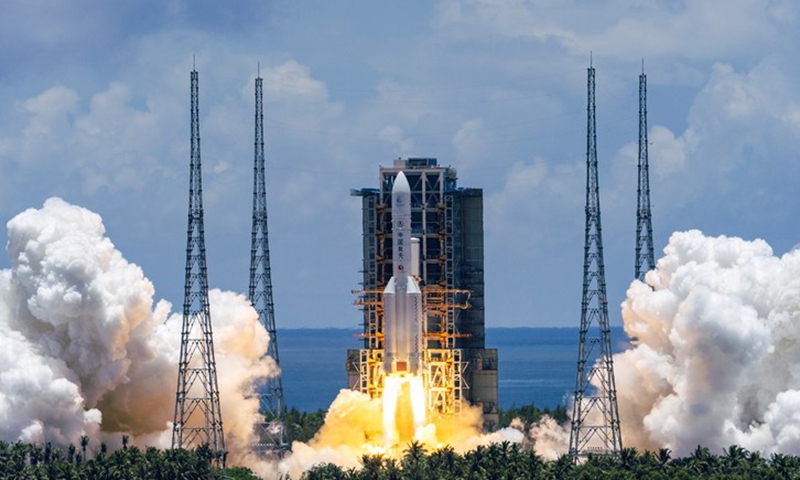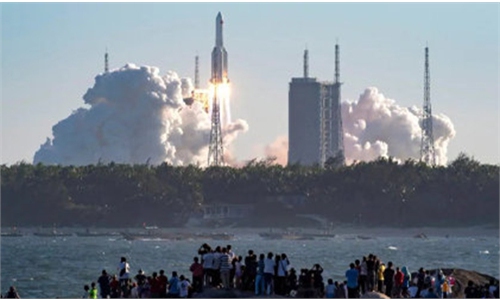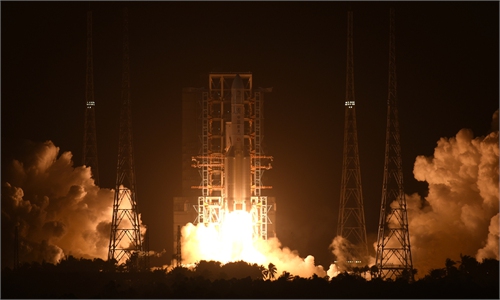SCI-TECH / AIR & SPACE
Long March rockets to support exciting phase of China’s space work in 2021

A Mars probe is launched on a Long March-5 rocket from the Wenchang Spacecraft Launch Site in south China's Hainan Province, July 23, 2020.Photo:Xinhua
Developers of the Long March rocket family have recently disclosed more exciting details of China's space endeavors in 2021, which is expected to see more than 40 launch missions including those tasked for the building of the country's first ever space station.
Long March-5B, Long March-7 and Long March-2F rockets will jointly execute launch missions for the space station construction from three launch pads in two space centers to send the core cabinet of the space station, Tianzhou-2 cargo spaceship and Shenzhou-12 manned spaceship, into space this year, and to complete docking and key in-orbit technological verification work, Global Times learned from the state-owned space giant China Aerospace Science and Technology Corporation (CASC) on Wednesday.
It is expected that following the launch of the space station core cabinet by the Long March-5B, the Long March-7 and Long March-2F will lift off in succession, and the specific windows for these two launches will be determined by the core cabinet mission situation, China's biggest rocket contractor CASC said.
In a recent interview with China Central Television (CCTV), Mou Yu, a CASC official, said that that the deployment of a combination of Long March rocket types in space station construction would also mark a first in China's space work.
As the space station construction demands several docking events in orbit between different spacecraft, such as the core cabinet with the crewed spaceship, the Long March rockets involved in the launch missions would pursue "zero window" launches, allowing no room for mistakes in the preparation stage, which would result in launch delays, space observers noted.
"[Such challenges] require and will further verify the high technological reliability and precision of China's space launch system," Wang Yanan, chief editor of Beijing-based Aerospace Knowledge magazine, told the Global Times on Wednesday.
Wang expressed confidence in China's in-orbit docking technological readiness, while noting, "I believe docking events for China's space station construction will be mainly automatic and robotic, with less manual involvement by the astronauts."
The CASC also revealed that Long March 11 will carry out four to five space launch missions this year, and apart from one from the ground launch pad, they will all be from sea platforms.
The Long March-11 carrier rocket had previously carried out the country's first seaborne space launch in June 2019 and a second [first commercial application launch] on September 15 in 2020.
The Long March 11 carrier rocket scheduling more than one sea launch a year would prove that China's seaborne space technology has greatly matured, expanding the service scope of China's space with lower costs and higher flexibility, Song Zhongping, a space observer and TV commentator, told the Global Times on Wednesday.
In theory, with its much improved sea launch capabilities, Long March-11 would be able to carry out missions from much wider water coverage, whether it is along China's coast or even international waters, meaning more orbit options and more agile launch windows, Wang said.
It can also be launched from waters close to customers' home soil, Song added, hinting at enhanced competitiveness in the global market.
According to Li Dan, deputy chief designer of the Long March-3A rocket family, the "Gold Medal Rocket" series will carry out more than 10 launches in the second half of 2021, at intervals of at least half a month, and the Long March-3B will also conduct parafoil recovery system experiments, with the aim of solving the problem of falling parts from rockets after missions to avoid affecting people's normal lives.




